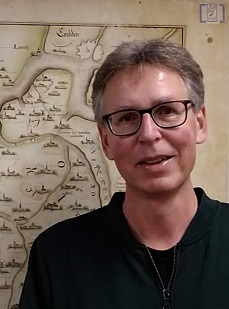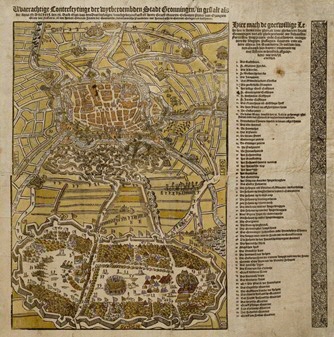Meet Evert Jan Reker, information and collection specialist for the Special Collections

“Our most important task at the Special Collections is to support the research and teaching at the UG. We supply materials for the support of lectures and seminars, collaborate on exhibitions, including digital ones, and process acquisition suggestions for the collection.”
The University Library Groningen (UB) holds approximately 3.5 million printed books. Some of these belong to the so-called Special Collections. Evert Jan Reker is an information and collection specialist for the Special Collections and works with these rare, valuable, and antique collection pieces.
What do the Special Collections of the UB entail?
The Special Collections (SC) distinguish themselves by the fact that these books are old (published before 1900) or rare. There are many unique copies in the safe, such as manuscripts, hand-drawn maps, archives of professors, and early prints that are considered extra valuable because of their history. The most well-known example of the last category is the copy of a bible translation by Erasmus that was owned and commented on by Maarten Luther (the 'Luther Bible').
Most SC items are in the UB repository. When these works are requested, they will be laid out for consultation in our room.
What is it you do as information and collection specialist for the Special Collections?
I take care of collection building of the Special Collections, for example in the area of book and library history. In addition, I represent the UB in the national platform of map curators of the Dutch universities, the National Library, and the National Archives. I am also the contact person for people who want to donate or bequest books to the library.
Our most important task at the SC is to support the research and teaching at the UG, but researchers from outside the University also know where to find us. Working for the Special Collections is very varied and involves a lot of teamwork. Everyone within the team has their own specialism.
With which types of questions can researchers and lecturers go to you?
We supply materials for the support of lectures and seminars, collaborate on exhibitions, including digital ones, and process acquisition suggestions for the collection.
A fine example of the collaboration with lecturers is the annual lecture given by Theo Spek, Professor of Landscape History, using our map collection. Students gain an insight into the use of geographical maps as a source for the history of the landscape. It’s exciting and fun for these students to be able to work with an original old map.
In addition, we support a lot of projects within and outside the research domain. At the moment, for example, biographies are being written about UG luminaries Frits Zernike and Jantine Tammes using our collection.
We also collaborate on exhibitions from other institutions. Right now, the Noordelijk Scheepvaartmuseum (Northern Maritime Museum) has several items from our collection on loan to display in their ODE (Tribute) exhibition. In the UB, we have our own exhibitions as well. Recently, there was a small exhibition of beautiful frontispieces from the magazine Europische Mercurius. The online exhibition can still be viewed.
How does the UB contribute to the accessibility of this type of heritage?
Although nothing beats the examining of original early prints, manuscripts, and maps, for many students and researchers digitization is very useful. We notice that now more than ever. A large part of our collection is already available for consultation online, such as most of our historical maps. Another reason for digitization is conservation, as it often concerns vulnerable materials.
At the moment, there is an ongoing UG-wide digitization project, which the Special Collections is collaborating on through the Frisia subproject. The digitization of a large number of our books, printed or written before 1614, with geographical information linked to them, will further increase the availability and the use of the UB collection.
What is your favourite item from the SC collection?
We have absolutely stunning old maps that are not only of great importance as historical sources but are often also very nice to look at. Take, for example, this map of the siege of the city of Groningen in 1594 by Prince Maurice.

More information
Special Collections & Opening hours
Gauronica blog
Contact
bijzonderecollecties-bibliotheek rug.nl
Follow the SC on Twitter

